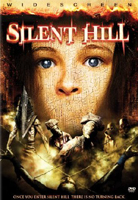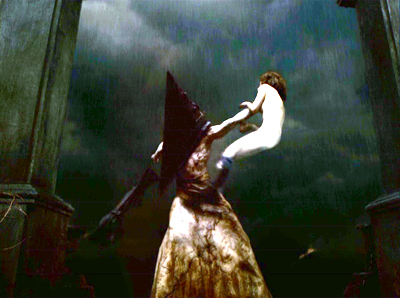 BUY IT AT AMAZON: CLICK HERE!
BUY IT AT AMAZON: CLICK HERE!
STUDIO: Sony
MSRP: $28.95
RATED: R
RUNNING TIME: 125 Minutes
SPECIAL FEATURES: Behind-the-scenes featurettes
The
Pitch
"It’s Dante Alighieri meets Clive Barker… in hell!"
The
Humans
Radha Mitchell, Sean Bean, Alice Krige, Debra
Kara Unger, Jodelle Ferland.
The
Nutshell
Young Sharon (Ferland) has been sleepwalking at
night, and mumbling from her dreams about a place called Silent Hill. Her
adopted mother, Rose (Mitchell), desperate to cure her child, tries bringing
Silent Hill in the hopes that confronting her dreams will clear whatever veil
from
nightmares. Unfortunately, Silent Hill isn’t much of a place to proactively
work through your psychological troubles, unless terror, torture, and rape are
your ideas of "proactive."

Really, it’s just the first warning sign of your child’s graphite deficiency.
The
Lowdown
Read Russ‘ moderately less enthusiastic take on the theatrical run.
Disclosure: Silent Hill 2 is my very favorite
video game, thanks to its complex, but personal, plot. Nothing that happens
within the framework of the story has any bearing on the world beyond its
protagonist, James Sutherland, and his very few relationships. It also features
abysmal dialogue and worse voice acting, is graphically inferior to its peers, and
gameplay without much of a challenge. Explaining why I like it to friends and
enemies generally devolves into something along the lines of:
"It’s got a giant penis in it! And
rape!"
Don’t worry, though. I’m not going to let my love
for the games (yes, even Silent Hill 4) color my review of
this ambitious, pretentious film adaptation of (mostly) the first entry in the
series. Director Christophe Gans and screenwriter Roger Avary, both talents
whom I respect quite a bit, lost their direction in this labor of love when
they forgot that what a Silent Hill story needs is a subtle,
coherent theme. Not only that, but what a film needs is strong acting, and good
dialogue, more so than a video game does because, frankly, video game audience
are more forgiving, or more distracted by gameplay.

I’d prefer an enema. Heck, I almost always prefer an enema.
The movie does have a theme, and it does feature
strong actors, but these factors fail to combine in Avary’s script to any
meaningful or horrific degree. The theme of the day is motherhood, or
parenthood, as it was in the first game. That game’s protagonist, Harry Mason,
was changed for the film into the character of Rose, because the filmmakers
decided an audience wouldn’t accept a man in what is essentially a feminist
role. They were probably right, but the result tips too far in the other
direction: Silent Hill ends up being a blatant collection of screeds for
and against motherhood that rings louder than the film’s trademark air-raid
siren.
Horror isn’t by nature an extraordinarily subtle
genre, of course, but the clammy, constricting atmosphere that is largely
successful throughout the film clashes drastically with the hamfisted
psychology digressions. As a result, the climactic scenes of gore and violence
come off as a spectacle where they seem they ought to have been torturous.
Another notable fumble of the theme is the
inclusions of certain monsters from the games. In the games, the monster
selection is pretty deliberately tied to the story, so that they embody certain
internalized fears of the hero. Some of the movie’s creatures work within the
theme of motherhood, such as the gray children. Others, on the other hand…
Two memorable monsters are transferred over from Silent
Hill 2: Pyramid Head and the busty nurse. In the game, both of these
creatures were designed to play on James’ unconscious sexual problems, which
form the foundation of his personal hell. In the movie, both are included
simply because they look cool. (And don’t get me wrong. Pyramid Head,
especially, is an incredible presence, and one of the most memorable monsters ever
to hit the silver screen.) I mean, I suppose you could cram a feminist/motherhood
criticism on top of the sexualized nurses and the eight-foot-tall penis, but it
would be an awkward fit. Especially with that helmet.

Enhanced like hell for glory.
That’s the essence of the problem with Silent
Hill: too much was included simply because it looks cool, and not
enough thought was given to internal coherency. You can pick up on this whether
you’re familiar with the game or not by the way the shoddy character arcs are
contained within a gorgeous production design.
The shoddiest of all arcs is that of Sean Bean’s
Christopher, Rose’s husband. While his wife searches for answers in the foggy and
hellish town of
Christopher explores the town as it exists in the real world. His sequences,
though acted with everything Mr. Bean can muster, are composed entirely of
exposition and artificial emotion. Christopher’s role seems as if it is
supposed to create more audience sympathy for Rose’s labor, but the only
emotional core it provides is a thin one to the very last scene. It’s a sad
waste of an actor of his caliber.
The production design, on the other hand, is
plainly worth every penny that was spent on it. The sets, and there are a lot
of them, are aged, falling apart, derelict, and burned. The level of detail is
incredible, even when the ever-present shadows are dispelled by a passing
flashlight. Gans should be applauded for deciding to make as much of the
production as he could with practical effects, costumers, makeup, and set
design. Making Silent Hill feel so much like a real place contributes to the
successful mood of the whole film.
The music, similarly, is top-notch. Game series
composer Akira Yamaoka contributes some pieces that will be familiar to those
who have played the games, while Jeff Danna expands on the eclectic,
half-melodic score. The music adds notes of dissonance that support the
sound-effects work cleverly and subtly.

Press UUDDLRLRBA on your remote to unlock this Easter Egg
of a screaming Konami executive.
There’s a lot to love about the technical aspects
of Silent
Hill. The cinematography is insistent and bold, and the monster design
is incredibly disturbing. It’s the narrative side of things that doesn’t hold
up its end of the weight. I feel as if Gans and Avary included too much in the
way of fan service and didn’t leave themselves enough room to tell a good,
moderately original story. They should have tried to piss off the fans a little
more, or at least not cared as much about pleasing them.
Gans and Avary both had a lot of love for the
source material. I guess this is a case study to stand opposite Peter Jackson’s
Lord
of the Rings films. Love and talent will only get you so far without a
good script.
I think it’s honestly fascinating to watch two
different media attempt to submerge its audience in a similar sense of horror.
Unfortunately, Silent Hill the film suffers too much from the horror equivalent
of "gee whiz!" design. It is horrifically beautiful, but beneath all
that rust, ash, and decay, there’s very little supporting it. Rape me surprised.
The
Package
For all the concessions the filmmakers made to
fans in the creation of the movie, they sure spend a lot of time apologizing in
the bonus features for how much they altered. The features on this disc are a
series of focused mini-documentaries about aspects of the film, and most of
them include Gans or Avary at some point making an apology as to why they
changed this part of the story, or did away with this character. These cover
casting, stunts, creature effects, and the like. The one on the creatures is
fascinating, because it exposes a number of the secrets of the practical
monster design, one of the film’s better qualities.
Oh, and if you disagree with my review, just
consider this: I reviewed the fullscreen version that the studio sent over.
What’s that, like 20% of the movie that I’m missing? Damnit, those 20% were the
best parts.
4.5
out of 10